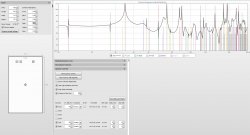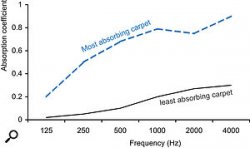Matthew J Poes
AV Addict
Thread Starter
- Joined
- Oct 18, 2017
- Messages
- 1,903
I've been thinking a lot about room acoustics lately. I recently completed my own dedicated theater, built from scratch as a mixed use room. I knew I wanted to infuse my views on acoustics into the design of that room and try ideas I often wanted to try but couldn't. Along the way I learned things that surprised me. Not in that I didn't expect the problems, but rather, I didn't expect them to be so bad.
(I'm going to attempt to break this up over multiple posts to make it easier to read, sorry for the long posts)
What is a good sounding room characterized by?
Low Ambient Noise: A room is made to have low ambient noise via soundproofing techniques. While a room can have low ambient noise simply by being in a quiet place and removing any noise making devices, HVAC vents for example, you would not be guaranteed of low ambient noise. As such a room must be made soundproof if you really want to keep out the outside sound. Making a room soundproof is not trivial, as noise penetration can enter in many different ways (sound radiation, sound re-radiation, foot fall, HVAC air noise, Fan rumble, etc.).
Here is the problem with soundproof rooms, they are highly reflective. In fact, I was completely shocked at just how much more reflective a soundproof space is! I've worked with spaces that have no real absorption but also no real soundproofing, and they are manageable. Adding relatively modest amounts of absorption can drastically improve clarity, reduce reverberation/decay, and improve perceived sound. In a soundproof space this just isn't so. The room becomes a nightmare acoustically in many ways. Adding modest but significant absorption (for example carpet) helps tremendously in the upper midrange and high frequencies, but once you start to move into lower frequencies those reflections remain strong and more serious absorption is needed.
In this image below, notice the room reflections on bass at low frequencies. Notice especially the garbage in the response between 80hz and 200hz. In fact, if we modeled this higher up, we would see even more garbage. This is the contribution of room reflections. This room models a normal living room and even allows for unusually absorbent carpet.

Is Carpet enough to fix the problem? I guarantee the room will sound 100 times better to any person after carpet is installed in a soundproof space, but look at that plot. We need a lot more absorption below 200hz to clean this up.
This gives a range of carpet absorption from least to most and shows that even the best carpets provide very little absorption below 200hz. Mots provide no meaningful absorption.

To really improve things we need to start seriously treating a room with significant absorption. Getting a wall to have an average absorption coefficient of say .5 below 200hz would require covering around 75% of the wall with 4" thick high density fiberglass (6lb density for example).
Covering nearly the entire front wall with about 4" of 3-6lb density fiberglass would certainly clean things up a lot. I'll post an image later of what that might look like, but it too is far from perfect.
(I'm going to attempt to break this up over multiple posts to make it easier to read, sorry for the long posts)
What is a good sounding room characterized by?
- Low ambient noise
- An ability to add no undesirable distortions
- Ambience (reverberation) that is minimal but appropriate for music
- Comfortable for extended periods of time
- Aesthetically pleasing (I think in as much as we taste with our eyes, our hearing can too be colored by what we see)
Low Ambient Noise: A room is made to have low ambient noise via soundproofing techniques. While a room can have low ambient noise simply by being in a quiet place and removing any noise making devices, HVAC vents for example, you would not be guaranteed of low ambient noise. As such a room must be made soundproof if you really want to keep out the outside sound. Making a room soundproof is not trivial, as noise penetration can enter in many different ways (sound radiation, sound re-radiation, foot fall, HVAC air noise, Fan rumble, etc.).
Here is the problem with soundproof rooms, they are highly reflective. In fact, I was completely shocked at just how much more reflective a soundproof space is! I've worked with spaces that have no real absorption but also no real soundproofing, and they are manageable. Adding relatively modest amounts of absorption can drastically improve clarity, reduce reverberation/decay, and improve perceived sound. In a soundproof space this just isn't so. The room becomes a nightmare acoustically in many ways. Adding modest but significant absorption (for example carpet) helps tremendously in the upper midrange and high frequencies, but once you start to move into lower frequencies those reflections remain strong and more serious absorption is needed.
In this image below, notice the room reflections on bass at low frequencies. Notice especially the garbage in the response between 80hz and 200hz. In fact, if we modeled this higher up, we would see even more garbage. This is the contribution of room reflections. This room models a normal living room and even allows for unusually absorbent carpet.

Is Carpet enough to fix the problem? I guarantee the room will sound 100 times better to any person after carpet is installed in a soundproof space, but look at that plot. We need a lot more absorption below 200hz to clean this up.
This gives a range of carpet absorption from least to most and shows that even the best carpets provide very little absorption below 200hz. Mots provide no meaningful absorption.

To really improve things we need to start seriously treating a room with significant absorption. Getting a wall to have an average absorption coefficient of say .5 below 200hz would require covering around 75% of the wall with 4" thick high density fiberglass (6lb density for example).
Covering nearly the entire front wall with about 4" of 3-6lb density fiberglass would certainly clean things up a lot. I'll post an image later of what that might look like, but it too is far from perfect.










